Differences in sectors
- Books Name
- Understanding Economic Development Class-10
- Publication
- PathSet Publications
- Course
- CBSE Class 10
- Subject
- Economics
DIFFERENCES IN SECTORS
- We see a lot of activities taking place around us. This involves producing goods and services.
- To understand these activities, we divide them into different groups known as sectors.

PRIMARY, SECONDAY & TERTIARY SECTORS
- The various activities are categorized into three categories: Primary, secondary and Tertiary sectors. Let us have a look at each of them.
PRIMARY SECTOR
- For the growth of cotton plant, we depend mainly on rainfall, sunshine and climate. The product i.e. cotton, is a natural product. Similarly, in the case of dairy, we depend on the biological process of animals and the availability of fodder. The product here, milk, is natural. Other examples of a natural product are minerals and ores.
- When we produce a good by exploiting natural resources, it is an activity of the primary sector.
- It is called primary because it forms the base of the products that we subsequently make.
- It is also called agriculture and related sector since most of the natural products we get are from agriculture, forestry, dairy, fishing etc.
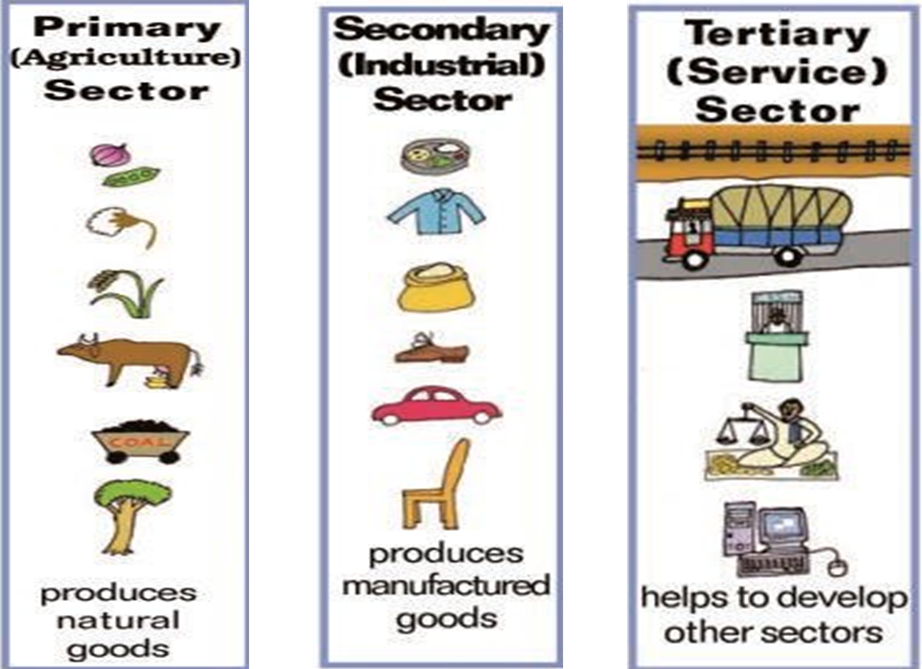
SECONDARY SECTOR
- The secondary sector, which is the second step, covers activities in which natural products are changed into other forms through ways of manufacturing that we associate with industrial activity.
- The product is not produced by nature but has to be made and therefore some process of manufacturing is essential.
- For example, the cotton that we saw in the primary sector now helps us to spin yarn and weave cloth. Using sugarcane as raw material, we make sugar or gur, the milk is used to make processed cheese etc.
- Since this sector gradually became associated with the different kinds of industries that came up, it is also called as industrial sector.
TERTIARY SECTOR
- Some activities fall neither in the category of the primary or secondary sector. They come under the tertiary sector
- These activities help in the development of the primary and the secondary sector.
- These activities, by themselves, do not produce good but they are an aid or
- support for the production process.
- For example, goods that are produced in the primary or secondary sector would need to be transported by trucks or trains and then sold in wholesale and retail shops.
- At times, it may be necessary to store these in godowns.We may need to communicate about these to consumers or maybe borrow money from banks to support them.
- Transport, storage, communication, banking, trade are some examples of tertiary activities.
- Since these activities generate services rather than goods, the tertiary sector is also called the service sector.
- It also includes additional services that do not help in the production of goods like Teaching, engineering etc.
- These sectors, although categorized differently, are interdependent.
Comparison between sectors
- Books Name
- Understanding Economic Development Class-10
- Publication
- PathSet Publications
- Course
- CBSE Class 10
- Subject
- Economics
COMPARISON BETWEEN SECTORS
- Now, the question arises, how do we count the various goods and services and know total production in each sector?
- For this, we find the value of goods and services rather than the quantity. For example, if 10,000 kg of wheat is sold at Rs.8, then the value of wheat is Rs.80, 000. In this way, the value of goods and services in the three-sector is calculated and then added up.
- However, some goods and services are not included in this. They are known as intermediate goods. For example, a farmer sells wheat to a flour mill at Rs.8 per kg. The mill grinds the wheat and sells the flour to a biscuit company for Rs.10 per kg. The biscuit company uses flour and things such as sugar and oil to make four packets of biscuits. It sells biscuits in the market to consumers for Rs 60 (Rs 15 per packet). Biscuits are the final goods, i.e., goods that reach the consumers. Here, wheat and wheat flour are examples of intermediate goods and therefore will be excluded to avoid the problem of double counting.

- Thus, intermediate goods can be defined as goods that help in producing final goods and services. The value of final goods and services includes the cost of intermediate goods. In the above example, the price of biscuits is inclusive of the price of wheat.
- The value of final goods and services produced in each sector during a particular year provides the total production of the sector for that year. Moreover, the sum of production in the three sectors gives what is called the Gross Domestic Product (GDP) of a country. It is the value of all final goods and services produced within a country during a particular year. GDP shows how big the economy is.
- A central government ministry undertakes GDP.
Changes in the sector with TIME
- The primary sector was the most important sector of economic activity. However, with the change in farming techniques, the agriculture sector began to prosper and produced much more food than before. Many people could now take up other activities. There was an increase in the number of craft persons and traders. Buying and selling activities increased many times. Besides, there were also transporters, administrators, army etc. However, a major section of the society was employed in the primary sector.

- Over the years, manufacturing was introduced and factories started coming up. People shifted from farming to manufacturing. The secondary sector thus gathered importance in total production and employment.
- However, another shift was observed. People started shifting from secondary to tertiary sector, which became the most important in terms of total production.
Importance of tertiary
- Books Name
- Understanding Economic Development Class-10
- Publication
- PathSet Publications
- Course
- CBSE Class 10
- Subject
- Economics
IMPORTANCE OF TERTIARY
- Over the last 40 years, production in all the three sectors has increased but the maximum increase was observed in the tertiary sector.
- As a result, in the year 2013-14, the tertiary sector has emerged as the largest producing sector in India replacing the primary sector. Let us look at the reasons behind the increase in the production of the tertiary sector.
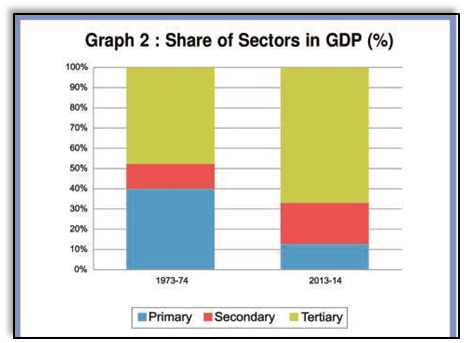
- First, in any country, several services such as hospitals, educational institutions, post and telegraph services, police stations, courts, village administrative offices, municipal corporations, defense, transport, banks, insurance companies, etc. are required. These can be considered as basic services.
- Second, the development of agriculture and industry leads to the development of services like transport, banking, insurance etc.
- Third, as income levels rise, certain sections of people start demanding many more services like eating out, tourism, shopping, private hospitals, private schools, professional training etc.
- Fourth, over the past decade or so, certain new services such as those based on information and communication technology have become essential. The production of these services has been rising rapidly.
THE MOST EMPLOYMENT GIVING SECTOR
- Even though there had been an increase in the production in all three sectors, still, more than half of the population was employed in the primary sector producing only 1/6th of the GDP, because there are not enough job opportunities in the secondary and tertiary sector.
- There are more people in agriculture than is necessary. So, even if you move a few people out, production will not be affected. In other words, workers in the agricultural sector are underemployed.
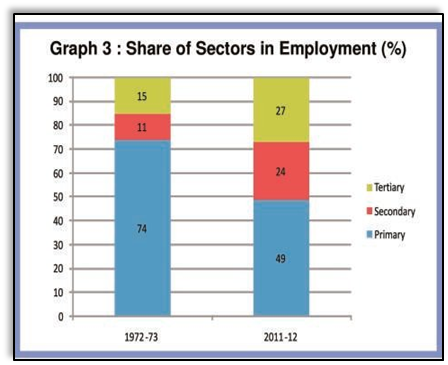
- In this case, labor effort is divided and everyone works less than their potential.
- This kind of underemployment is hidden in contrast to someone who does not have a job and is visible as unemployed. Hence, it is also called disguised unemployment.
- If we remove many people from the agricultural sector and provide them with proper work elsewhere, agricultural production will not suffer. The incomes of the people who take up other work would increase the total family income.
- This underemployment can also happen in other sectors. For example, there are thousands of casual workers in the service sector in urban areas who search for daily employment. They are employed as plumbers, painters etc. They are doing this work because they do not have better opportunities.
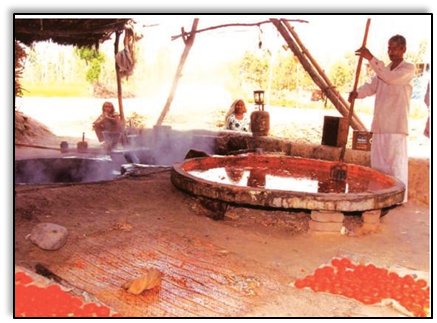
- However, there are certain ways to create more employment. It can be done as:
- Putting unirrigated land on use by the development of irrigation facilities (for example, construction of wells, dams etc.), will enable more crops to be produced on land and better utilization of workers.
- If the government invests some money in transportation and storage of crops or makes better rural roads so that mini-trucks reach everywhere several farmers, who now have access to water, can continue to grow and sell these crops. This activity can provide productive employment to not just farmers but also others such as those in services like transport or trade.
- We also need to provide cheap agricultural credit to the farmers for farming to improve.
- Open cold storage. It can allow farmers to store their products like potatoes and onions and sell them when the price is good.
- In villages near forest areas, we can start honey collection centers where farmers can come and sell wild honey. It is also possible to set up industries that process vegetables and agricultural produce like potato, sweet potato, rice, wheat, tomato, fruits, which can be sold in outside markets. This will employ in industries located in semi-rural areas and not necessarily in large urban centers.
- A study conducted by the erstwhile Planning Commission (now known as NITI Aayog) estimates that nearly 20 lakh jobs could be created in the education sector alone. Similarly, if we are to improve the health situation, we need many more doctors, nurses, health workers etc. to work in rural areas.
- The central government in India made a law implementing the Right to Work in about 625 districts of India. It is called Mahatma Gandhi National Rural Employment Guarantee Act 2005 (MGNREGA 2005).

- Under MGNREGA 2005, all those who can, and need, work in rural areas are guaranteed 100 days of employment in a year by the government. If the government fails in its duty to provide employment, it will give unemployment allowances to the people. The types of work that would in the future help to increase the production from land will be given preference under the Act.
Organised of an organised Sectors
- Books Name
- Understanding Economic Development Class-10
- Publication
- PathSet Publications
- Course
- CBSE Class 10
- Subject
- Economics
ORGANISED & UNORGANISED SECTOR
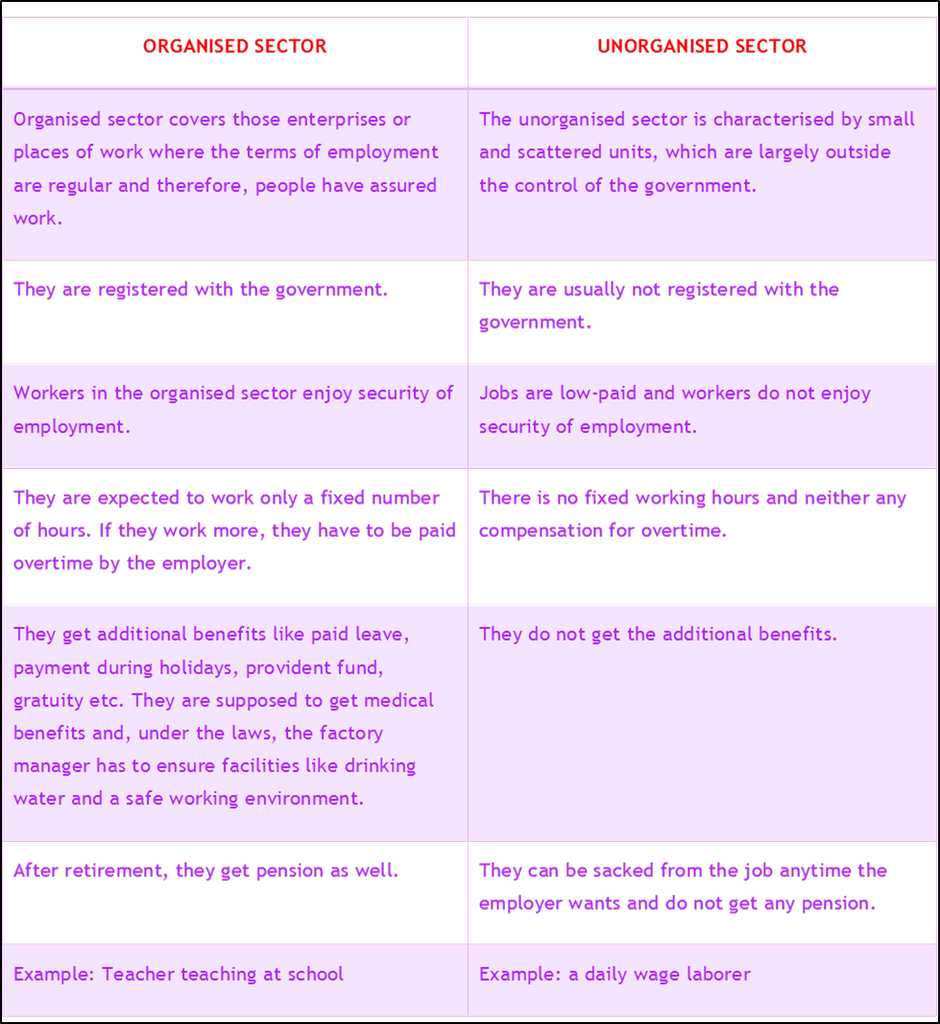
PROTECTION OF WORKERS IN UNORGANISED SECTOR
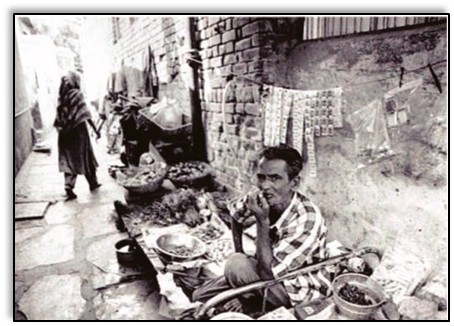
- Workers are forced to enter into unorganized sectors due to
a)lack of jobs in organized sectors
b)Some organized sector enterprises enter into unorganized sectors to evade taxes and reduce the benefits of workers. - This calls for a need for the protection and support of workers in the unorganized sector.
- In the rural areas, the unorganized sector mostly comprises landless agricultural laborers, small and marginal farmers, sharecroppers and artisans.
- Nearly 80 percent of rural households in India are in the small and marginal farmer category. These farmers need to be supported through the adequate facility for timely delivery of seeds, agricultural inputs, credit, storage facilities and marketing outlets.
- In the urban areas, the unorganized sector comprises mainly of workers in the small-scale industry, casual workers in construction, trade and transport etc., and those who work as street vendors, head load workers, garment makers, rag pickers etc. These small-scale industries need the support of the government.
- We also find that majority of workers from scheduled castes, tribes and backward communities find themselves in the unorganized sector. Besides getting irregular and low-paid work, these workers also face social discrimination.
- Protection and support to the unorganized sector workers is thus necessary for both economic and social development.
Private and Public Sector
- Books Name
- Understanding Economic Development Class-10
- Publication
- PathSet Publications
- Course
- CBSE Class 10
- Subject
- Economics
SECTORS IN TERMS OF OWNERSHIP: PUBLIC AND PRIVATE GOODS
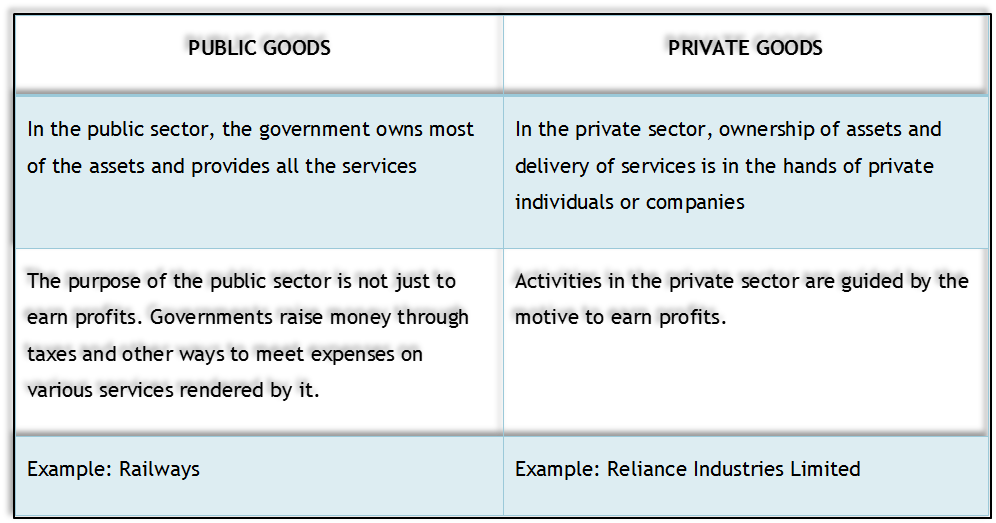
- The services mentioned above that the government provides are as follows:
- Construction of roads, bridges, railways, harbors, generating electricity, providing irrigation through dams etc.
- Government produces and supplies services like electricity at rates that are affordable to all and encourages the continuation of various industries and activities.
- It also buys certain commodities from farmers at a fair price and sells them at lower prices at ration shops.
- Running proper schools and providing quality education, particularly elementary education.
- The government also needs to pay attention to aspects of human development such as the availability of safe drinking water, housing facilities for the poor and food and nutrition.
- It is also the duty of the government to take care of the poorest and most ignored regions of the country through increased spending in such areas.

 PathSet Publications
PathSet Publications
